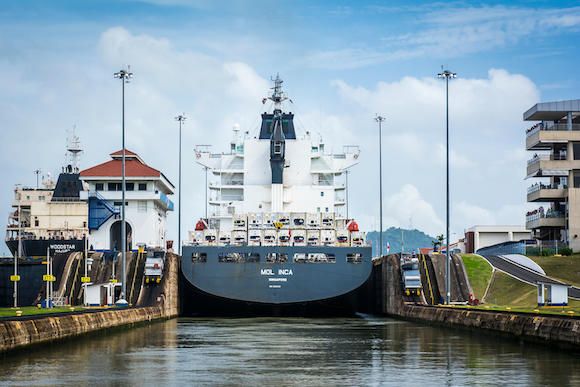They are the two most vital shortcuts of world trade, two engineering breakthroughs that over a century ago altered maps and pushed the boundaries of what was possible in maritime shipping. The canals of Suez and Panama have long seemed twinned. “There is only one maritime project which comes close to the scale of this, and that is Suez,” the guide at the Panama Canal museum cheerfully explains.
But in recent weeks, that tone has changed. After the 220,000-tonne Ever Given container ship ran aground in Suez, causing a six-day blockage that affected a tenth of all global trade, Panamanian officials have been going out of their way to stress that their canal is not so similar to its Egyptian cousin.
“We are a freshwater canal with locks. The Suez depends more on the ocean tide,” Ricaurte Vásquez Morales, the administrator of the Panama Canal, told the trade magazine American Shipper, in answer to the question “could it happen here?” He added that the idea of a ship running aground inside the canal, which first opened in 1914, remained improbable.
His argument has some merit. The Panama Canal is shorter, narrower and much more tightly controlled than Suez. The maximum-sized vessel that is permitted to navigate it weighs around 120,000 tonnes, far nimbler than the unwieldy beasts that ply the Suez. In the last 20 years there has been about one “incidento”—typically a scrape between a ship and a canal wall—per 4,000 crossings in Panama. In Suez, the incident rate is higher: around one in 1,100 crossings.
But the risk of a mishap in Panama is not zero, and it may be creeping up. And distant Suez might have a part to play there. In 2016, in an effort to future-proof the ageing canal and avoid losing the profitable market in big vessels to Suez (for a journey from New York to Hong Kong, the easterly and westerly routes are almost equidistant), the Panama was widened to allow larger ships to make the crossing. The new limit is known as “Neopanamax,” and it is about 1.5 times the volume of the previous limit. Within weeks three incidents occurred. The most serious involved a Chinese container vessel, the Xin Fei Zhou, which hit a wall while transiting on the Atlantic side of the canal. The ship’s hull was damaged, but canal traffic was not significantly held up.
That year, the International Transport Workers’ Federation formally complained that the new locks were too small for safe operation, arguing that they did not give the tugboats that manoeuvred the ships inside the locks room to operate, and suggesting corners had been cut in search of bigger profits. The Panama Canal Authority successfully disputed the complaint, insisting the widening of the canal had been meticulously designed and was subject to the most rigorous safety checks in the world.

Venezuelan captain Fernando Andrade, who has sailed merchant vessels through both canals dozens of times, warns that overconfidence is dangerous, because in shipping nothing is ever fail-safe. “Human error or some natural event is always possible,” he says. One particularly vulnerable area in Panama, he says, is a chicane-like area of the canal between two of its locks, which navigators refer to as “the snake.”
But he still feels more confident crossing Panama than Suez. A key difference is the weather. High winds can make navigating the Panama Canal complicated, but in Suez, which is bordered by desert, winds often mean sandstorms, reducing visibility to a few metres. The precise cause of the Ever Given disaster in which the huge vessel ended up diagonally grounded has not been definitively established. But the effect of sand in the air appears to have been a factor, both confusing the pilot and possibly stalling the main engines as a result of sand ingress.
Captains also say the procedures at the Suez Canal, which opened in 1869, are quite different to Panama’s. When a ship crosses the Suez, a local pilot will come on board and operate as an adviser, but formal command-and-control remains with the ship’s captain. In Panama responsibility for the ship passes to the local pilot the moment the vessel enters the canal. “Here at the Panama Canal, we take control of the vessels,” says Vásquez Morales, the canal administrator.
Ship operators describe a more disciplined, almost military, environment in Panama. By contrast, Suez is nicknamed the “Marlboro canal” by some regulars—crews can avoid inflated, sometimes trumped-up fines by gifting cartons of cigarettes to officials. “Yes, it does happen,” says Captain Andrade, adding that it never does in Panama.
When the final report is released into what caused the Ever Given fiasco, it will likely point to an unavoidable truth: the inherent risk of sailing vessels the size of tower blocks through waterways first designed for steamships. The Panamanian authorities will be reading it carefully. Suez has given the world a warning that the canals that help drive global trade can also be the places where it grinds to a halt.













